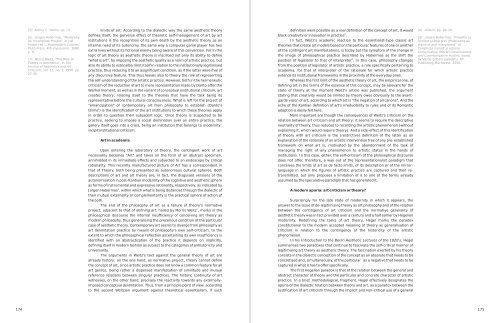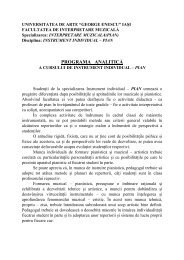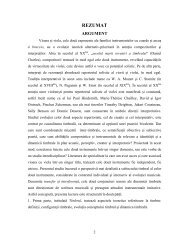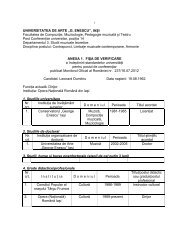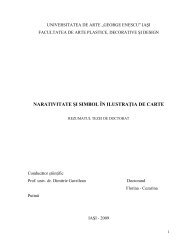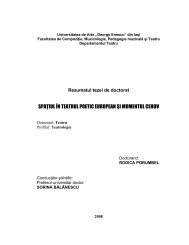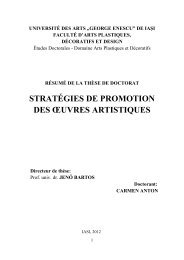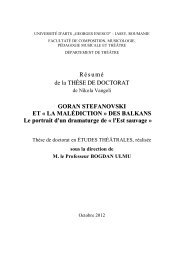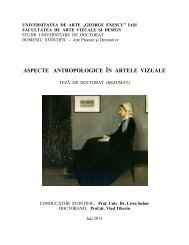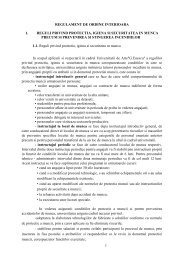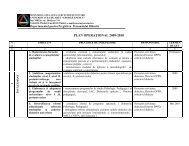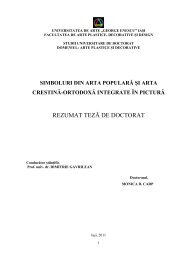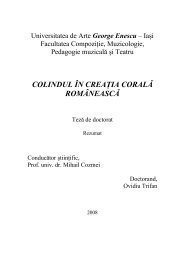vector 2_1.cdr - Universitatea de Arte "George Enescu"
vector 2_1.cdr - Universitatea de Arte "George Enescu"
vector 2_1.cdr - Universitatea de Arte "George Enescu"
Create successful ePaper yourself
Turn your PDF publications into a flip-book with our unique Google optimized e-Paper software.
174<br />
[5] Arthur C. Danto, op. cit..<br />
[6] Jürgen Habermas, “Mo<strong>de</strong>rnity:<br />
An Incomplete Project”, in Hal<br />
Foster (ed.), Postmo<strong>de</strong>rn Culture,<br />
Pluto Press, 4th impression, 1990,<br />
p. 9.<br />
[7] Morris Weitz, “The Role of<br />
Theory in Aesthetics”, in The<br />
Journal of Aesthetics and Art<br />
Criticism, vol. 15, no. 1, 1956, pp.<br />
27-35.<br />
limits of art. According to the dialectic way the same aesthetic theory<br />
<strong>de</strong>fines itself, the perverse effect of theoretic self-management of art by art<br />
institutions is the recognition of its own <strong>de</strong>ath by the aesthetic theory as an<br />
internal need of its autonomy, the same way a computer game player has two<br />
extra lives without its fictional enemy being aware of this convention. For in the<br />
logic of art theory as aesthetic theory is inscribed not only its ability to <strong>de</strong>fine<br />
"what is art", by imposing the aesthetic quality as a norm of artistic practice, but<br />
also its ability to ostensibly limit itself in relation to the institutionally legitimised<br />
practice, thus reducing it to an asignificant condition, as if the latter were free of<br />
any discursive feature. This thus leaves also to theory the role of representing<br />
the self-un<strong>de</strong>rstanding of the artistic practice. However, both in the hermeneutic<br />
criticism of the reduction of art to mere representation ma<strong>de</strong> by Danto after the<br />
Warhol moment, as well as in the variant of conceptual institutional criticism, art<br />
creates theory, relating itself to the theories that have the task being its<br />
representative before the cultural consciousness. What is left for the project of<br />
"emancipation" of contemporary art from philosophy to establish (Danto's<br />
5<br />
terms ) is the i<strong>de</strong>ntification of the art institutions to which these theories apply<br />
in or<strong>de</strong>r to question their subjacent logic. Once theory is suspected to be<br />
practice, seeking to impose a social domination over an entire practice, the<br />
gallery itself goes into a crisis, being an institution that belongs to mo<strong>de</strong>rnity:<br />
incipit institutional criticism.<br />
Art in aca<strong>de</strong>mia<br />
Upon entering the laboratory of theory, the contingent work of art<br />
necessarily becomes "Art" and takes on the form of an abstract specimen,<br />
annihilated in its immediate effects and subjected to an endoscopy by critical<br />
rationality. This recently manufactured picture of Art has a correspon<strong>de</strong>nt in<br />
that of Theory, both being presented as autonomous cultural spheres. Both<br />
<strong>de</strong>scriptions of art and art theory are, in fact, the disguised versions of the<br />
autonomisation in post-Kantian mo<strong>de</strong>rnity of the cognitive and aesthetic sphere<br />
as forms of instrumental and expressive rationality, respectively, as indicated by<br />
6<br />
Jürgen Habermas , within which what is being distanced through the dialectic of<br />
their mutual externality or complementarity is the practical sphere of action of<br />
the both.<br />
The end of the philosophy of art as a failure of theory's normative<br />
7<br />
project, adjacent to that of <strong>de</strong>fining art, hailed by Morris Weitz , marks in the<br />
philosophical discourse the internal insufficiency of conceiving art theory as<br />
mo<strong>de</strong>rn philosophy, thus generalising the precarious condition of the particular<br />
case of aesthetic theory. Contemporary art seems to diverge from philosophy as<br />
art <strong>de</strong>limitation practice by means of philosophy's own self-criticism, to the<br />
extent to which the philosophical reflection ascertaining its own insufficiency is<br />
i<strong>de</strong>ntified with an abstractization of the practice it <strong>de</strong>pends on implicitly,<br />
<strong>de</strong>fining itself in mo<strong>de</strong>rn fashion as subject to the categories of anhistoricity and<br />
universality.<br />
The arguments in Weitz's text against the general theory of art are<br />
already history: on the one hand, as normative project, theory cannot <strong>de</strong>fine<br />
the concept of art, since artistic practice does not know a common feature for all<br />
art genres, being rather a dispersed manifestation of similitu<strong>de</strong> and mutual<br />
reference relations between singular practices. The historic continuity of art<br />
witnesses, on the other hand, precisely the reactivity towards any externallyimposed<br />
conceptual <strong>de</strong>limitation. Thus, from a principle point of view, according<br />
to the second Weitzian argument against theoretical essentialism,<br />
if such<br />
<strong>de</strong>finition were possible as a real <strong>de</strong>finition of the concept of art, it would<br />
8<br />
block creativity or innovation in practice .<br />
In fact, Weitz's aca<strong>de</strong>mic reaction to the essentialist-type classic art<br />
theories that create art mo<strong>de</strong>ls based on the particular features of one or another<br />
of the contingent art manifestations, is today but the symptom of the change in<br />
the image of philosophical practice <strong>de</strong>scribed by Habermas as the shift the<br />
9<br />
position of legislator to that of interpreter . In this case, philosophy changes<br />
from the position of legislator of artistic practice, a role specifically pertaining to<br />
aca<strong>de</strong>mia, for that of interpreter of the rationale for which artistic practice<br />
extends its institutional frameworks in the proximity of the everyday ones.<br />
Whereas the first limit of the aesthetic theory of art, the empirical one, of<br />
<strong>de</strong>fining art in the terms of the essence of this concept, may be relevant for the<br />
state of theory at the moment Weitz's article was published, the argument<br />
stating that creativity would be limited by theory owes obviously to the avantgar<strong>de</strong><br />
vision of art, according to which art is "the negation of all canons". And the<br />
echo of the Kantian <strong>de</strong>finition of art's irreducibility to rules and of its Romantic<br />
adoption is easily felt here.<br />
More important are though the consequences of Weitz's criticism on the<br />
relation between art criticism and art theory: it seems to require the <strong>de</strong>scriptive<br />
neutrality of theory, thus reduced to recording the artistic phenomenon (without<br />
explaining it, which would require theory). And a si<strong>de</strong>-effect of this i<strong>de</strong>ntification<br />
of theory with art criticism is the (restrictive) <strong>de</strong>finition of the latter as an<br />
explanation of the rationale of an artistic intervention free of any pre-established<br />
framework on what art is, motivated by the abandonment of the task of<br />
managing the right of any phenomenon to artistic status in the hands of<br />
institutions. In this case, either, the self-criticism of the philosophical discourse<br />
does not offer, therefore, a way out of the representationalist paradigm that<br />
conceives the limits of art as <strong>de</strong> facto limits, of its <strong>de</strong>scription or of the mirrorlanguage<br />
in which the figures of artistic practice are captured and then retransmitted,<br />
but only proposes a limitation of it to one of the terms already<br />
assumed by the speculative paradigm that has generated it.<br />
A mo<strong>de</strong>rn aporia: art criticism or theory?<br />
Surprisingly for the late state of mo<strong>de</strong>rnity in which it appears, the<br />
answer to the issue of <strong>de</strong>-legitimising theory as art philosophy and of the relation<br />
between the contingency of art criticism and the normative generality of<br />
aesthetic theory was in fact provi<strong>de</strong>d over a century and a half earlier by Hegelian<br />
mo<strong>de</strong>rnity. Re<strong>de</strong>fining the tasks of art theory, Hegel marks the paradox<br />
constitutional to the mo<strong>de</strong>rn accepted meaning of theory as generalisation of<br />
criticism in relation to the contingency of the historicity of the artistic<br />
phenomenon.<br />
In his Introduction to the Berlin Aesthetic Lectures of the 1820's, Hegel<br />
summarises two paradoxes that continue to fascinate the self-critical manner of<br />
legitimising art theory as aesthetic theory. The fascination exerted by his theory<br />
consists in the dialectic conception of the concept as an absolute that needs to be<br />
concretised and, simultaneously, of the particular as a negative that needs to be<br />
captured in what it has to offer specifically.<br />
The first Hegelian paradox is that of the relation between the general and<br />
abstract character of theory and the particular and concrete character of artistic<br />
practice. In a brief, methodological, fragment, Hegel effectively <strong>de</strong>signates the<br />
aporia of the dialectic relation between theory and art, as a paradox between the<br />
justification of art criticism through the implicit and non-critical use of a general<br />
[8] ibi<strong>de</strong>m, pp. 29-30.<br />
[9] Jürgen Habermas, “Filosofia ca<br />
locţiitor şi interpret (Philosophy as<br />
stand-in and interpreter)” in<br />
Conştiinţa morală şi acţiune<br />
comunicativă (Moral Consciousness<br />
and Communicative Action), transl.<br />
by Vasile-Gilbert Lepădatu, All<br />
Publishing, Bucharest, 2000.<br />
175


